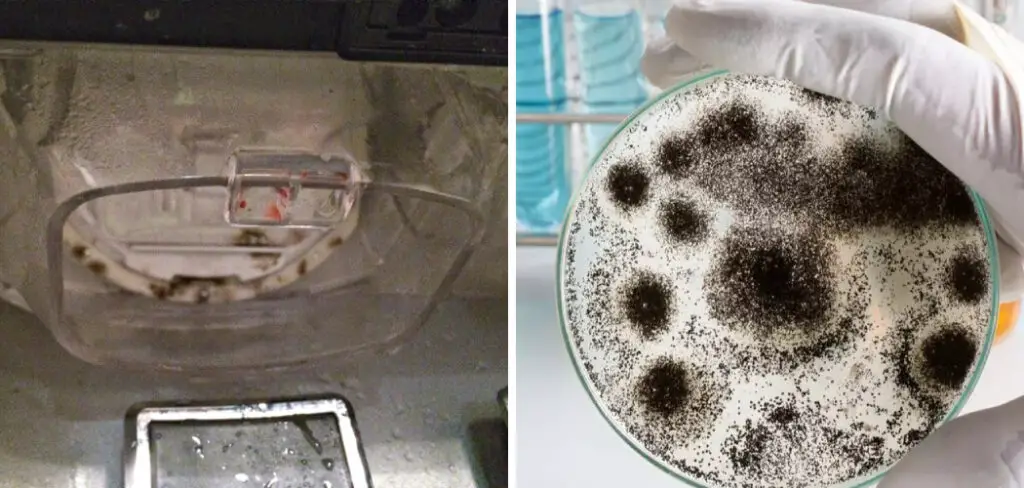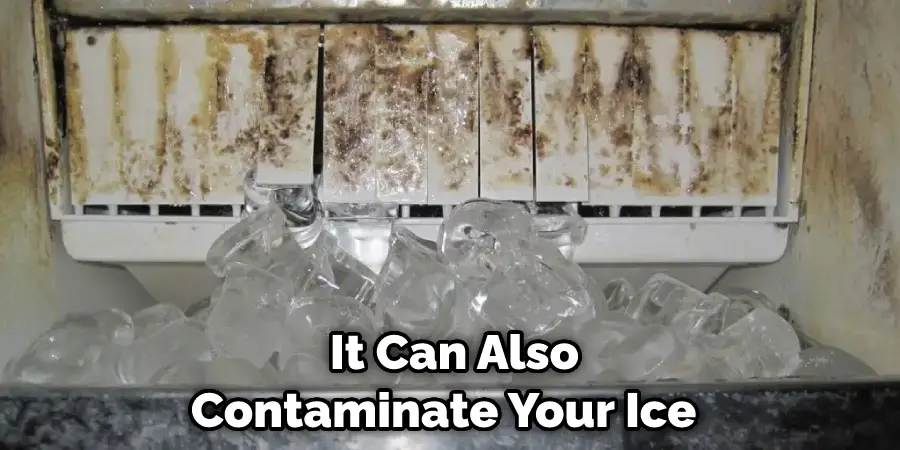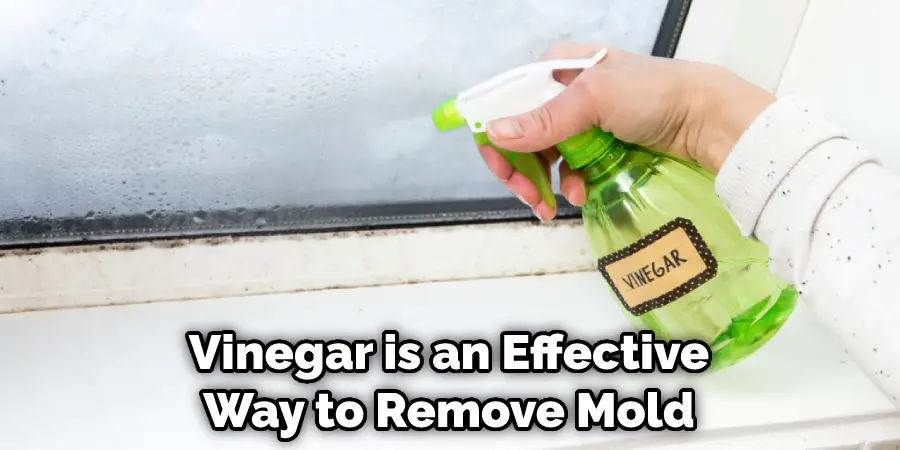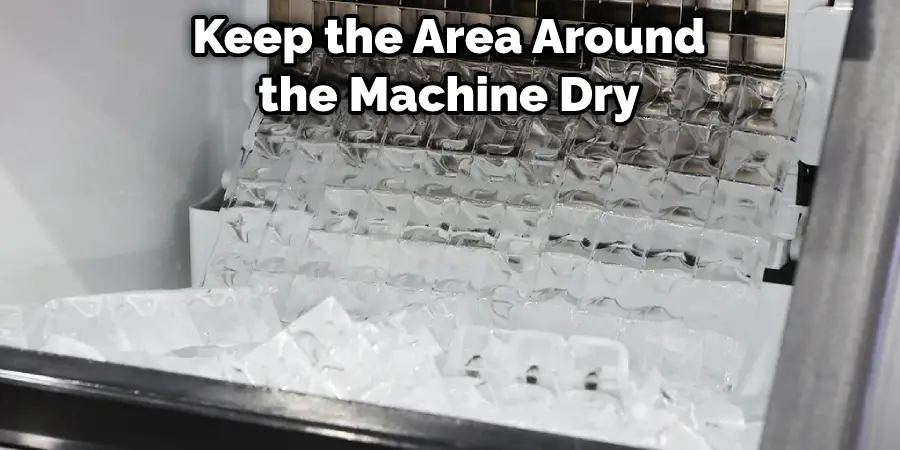Mold can be difficult to clean and get rid of, especially if it’s in hard-to-reach places. One place mold often grows is in ice makers. If you think your ice maker has mold, don’t worry – there are ways to clean it and get rid of it for good. If you find mold in your ice maker, it’s important to clean it right away.

Mold can cause serious health problems, so it’s not something to ignore. This blog post will show you how to clean mold from ice maker quickly and easily. Follow these steps, and you’ll have mold-free ice in no time! Read on for more information.
What Causes Mold Growth on Ice Maker?
Mold is caused by the growth of fungi in warm, moist environments. For example, mold can grow in an ice maker if there’s standing water or moisture in the machine. This can happen due to old ice melting, condensation, and poor maintenance.
Mold spores are everywhere, so all it takes is the right environment for them to grow. If your ice maker isn’t regularly cleaned and maintained, it’s more likely to develop mold. A malfunctioning ice maker can also cause it. If your machine isn’t making enough ice, it may stay too warm and create an environment favorable for mold growth.
Why Should You Clean Mold Growth on Ice Maker?
Mold can cause serious health problems if it’s not removed. Inhaling mold spores can cause coughing, wheezing, and other respiratory issues. It can also trigger asthma attacks and allergies. Mold may also be toxic, so if you have it in your ice maker, it’s important to clean it as soon as possible. If your ice maker has mold, it can also contaminate your ice and make it unsafe to consume. It can also affect the taste and quality of your ice, so cleaning it is important for maintaining your ice maker’s performance.

Needed Materials:
To clean mold from your ice maker, you will need the following materials:
White Vinegar:
This is a natural and effective cleaner that can kill mold spores.
Warm Water:
Use warm water to mix with the vinegar for cleaning.
Spray Bottle:
This will make it easier to apply the solution to hard-to-reach areas of the ice maker.
Dish Soap:
This will help remove any dirt or grime that may be contributing to the mold growth.
Cloth or Sponge:
Use a cloth or sponge to wipe down the ice maker after applying the cleaning solution.
Toothbrush:
A toothbrush can be used to scrub away tough mold spots in corners and crevices.
10 Effective Ways How to Clean Mold From Ice Maker:
1. Using Soft Cloth and Warm Water
Clean the interior of your ice maker with a soft cloth and warm, soapy water. For best results, use a mild all-purpose cleaner or diluted white vinegar. Rinse the cloth in clean water after each wipe to prevent any soap residue from getting into your ice cubes. If the mold is more stubborn, use a soft-bristled brush for scrubbing.
You can also use this cleaning method for the exterior of your ice maker. It’s important to clean the entire machine, as mold can easily spread. But be sure to unplug the ice maker before cleaning.
2. Use Bleach Solution
Mix one part bleach and five parts water in a spray bottle and shake well to mix. Spray the solution onto the moldy area of your ice maker, making sure to cover all affected surfaces. Allow the bleach solution to sit for 10 minutes before wiping it away with a soft cloth. Rinse the ice maker thoroughly with clean water and dry it completely before using.
But be cautious when using bleach as it can discolor or damage certain surfaces. If you’re unsure, test the solution on a small, inconspicuous area first. Our next cleaning method is just as effective and less harsh.
3. Use Vinegar Solution
Vinegar is an effective way to remove mold from your ice maker. To do this, mix ¼ cup of white vinegar with 1 gallon of water and pour it into a spray bottle. Spray the mixture onto all areas of the ice maker where you can see mold growth. Use an old cloth or sponge to remove the excess solution and mold residue. Rinse the area thoroughly with clean water and dry with a soft cloth. This solution will help kill any remaining mold spores and prevent them from spreading further.

It’s important to note that the smell of vinegar may linger for a short time, but it will dissipate quickly. But if you’re sensitive to the smell, you can add a little bit of lemon juice or essential oils to mask the odor.
4. Use Hydrogen Peroxide
Another effective way to clean mold from your ice maker is by using hydrogen peroxide. Mix one part hydrogen peroxide and two parts water into a spray bottle and shake until combined. Spray the mixture onto your ice maker’s affected surfaces, covering any visible mold growth. Allow the solution to sit for 10 minutes before wiping it off with a damp cloth.
For stubborn spots, you can use a soft-bristled brush to scrub the affected surface before wiping it off. Finally, rinse the area with clean water and dry thoroughly with a paper towel. This method is particularly effective if combined with white vinegar, as hydrogen peroxide helps kill bacteria that might remain on surfaces after using vinegar.
5. Use Ammonia
Ammonia is another effective cleaning agent that can be used to kill mold. To use it, mix one cup of ammonia with three cups of water in a bowl. Then, use a sponge or brush to scrub the moldy areas with the mixture.
Let the mixture sit on the mold for at least 10 minutes before wiping it away with a clean cloth. Next, rinse the area with water and dry it completely. Be sure to wear gloves and protective eye gear while cleaning with ammonia, as it can be dangerous if used improperly. After you are done, ventilate the area thoroughly before re-activating your ice maker.
6. Use Lime Juice
Lime juice is another effective way to clean mold from your ice maker. Lime juice is a natural disinfectant that can kill mold spores. Simply apply lime juice directly to the affected areas of your ice maker using a cloth or sponge. Then, use a cloth or sponge to scrub away the mold spores. Afterward, wipe the area with clean water to remove any residue. Ensure that all the lime juice has been removed before using your ice maker again.

This method is an effective way to remove mold from your ice maker without using harsh chemicals. You can also use lemon juice as an alternative to lime juice.
7. Apply Heat
Another way to kill mold on your ice maker is by applying heat. Set the temperature of your ice maker slightly above what is necessary for it to freeze, and allow the appliance to run for a few hours. The heat will help kill any remaining mold spores in the machine, preventing them from spreading further. Additionally, ensure that your ice maker is well-ventilated, as heat and moisture can create an ideal environment for mold growth. Once you’ve completed this step, let the machine cool down and begin making ice again, as usual.
You can also use this method in combination with other cleaning solutions for even more effective results. These next methods are also good to use in combination with other cleaning solutions.
8. Sanitize Your Ice Maker
After thoroughly cleaning your ice maker with soap and water, it’s important to sanitize it to eliminate any remaining mold or bacteria. Mix one tablespoon of chlorine bleach with 1 gallon of water and use a soft cloth to wipe down the interior surfaces.
After you’ve wiped the surface, rinse it thoroughly with clean water. You should also repeat this process for any other removable parts, such as the ice bin or water filter. Once you’ve sanitized your ice maker, air dries them completely before reassembling them.
9. Clean and Replace Your Water Filter
If your ice maker has a water filter cartridge, it’s important that you clean and replace it regularly to prevent mold growth. To clean the filter cartridge, turn off the water supply to your ice maker and remove it from its housing. Clean it with a soft brush or cloth dampened with mild detergent and warm water. Rinse thoroughly and let it dry before replacing it in its housing. Replace the water filter cartridge every six months for optimal performance.
You can also consider using a water filter system for your entire household to ensure that the water being used in your ice maker is clean and free of mold-causing bacteria.
10. Dry the Area
To prevent future mold growth on your ice maker, it’s important to keep the area around the machine dry. Remove any moisture in and around the appliance with a soft cloth or paper towel. Additionally, try to avoid overfilling your ice bin, as excess moisture could cause mold spores to form. Finally, consider using a dehumidifier to keep the air dry if you live in an area with high humidity levels. With these steps, you can help ensure mold won’t come back!

It’s important to regularly clean and maintain your ice maker to prevent the growth of mold and other harmful bacteria. With these easy steps and natural cleaning solutions, you can keep your ice maker clean and functioning properly for years to come. Remember to also follow proper food safety guidelines when handling and storing ice from your ice maker to ensure your health and the safety of you and your family.
Following these steps, you can effectively remove mold from your ice maker and keep it in top shape! Additionally, make sure to regularly clean your ice maker with a vinegar-water solution to prevent the growth of mold and other bacteria. Taking the time to maintain your ice maker properly will help ensure that you always have fresh, clean ice for your drinks.
Do You Need to Use Professionals Help?
In most cases, you can effectively clean and remove mold from your ice maker on your own. However, if the mold growth is extensive or if you have any underlying health conditions that may put you at risk, it’s best to seek professional help. Additionally, if the mold growth keeps recurring despite regular cleaning and maintenance, it may be a sign of a larger issue with your ice maker that requires professional attention. In these instances, it’s best to contact an experienced mold remediation specialist to properly assess and address the situation.
Overall, it’s important to take proper care of your ice maker to prevent mold growth and ensure your safety and that of your family when using it. With these tips, you can maintain a clean and functional ice maker for all your cold beverage needs.
Additional Tips and Advice to Prevent Mold Growth in the Future:
1. Keep the ice maker clean. Regularly wiping down the outside of the ice maker and inside surfaces with a damp cloth or sponge is an effective way to keep mold growth at bay.
2. Monitor water levels. Make sure that you’re regularly checking on your ice maker’s water levels, as too much water can increase moisture and cause mold to grow.
3. Keep it dry. Make sure you’re using a damp cloth or sponge when cleaning the ice maker, and then dry off any excess water with a clean cloth.
4. Keep the area ventilated. Opening windows or running a fan in the room can help keep air circulating and reduce the humidity, which helps to prevent mold growth.
5. Clean out ice trays regularly. Throw away old cubes harboring mold spores and clean your trays with hot, soapy water before refilling them with fresh ice.
6. Change your filter frequently. If you have an ice maker with a built-in filter, change it regularly, as old filters can trap moisture and encourage mold growth.
Following these tips can help you keep your ice maker clean and reduce the risk of mold developing in the future. If you follow these simple steps, your ice maker should stay free from any dangerous or unpleasant mold growth.
Frequently Asked Questions:
Q: How Often Should I Clean My Ice Maker?
A: It’s recommended to clean your ice maker at least once every few months or whenever you notice mold or other buildup. You should also clean it before and after extended periods of non-use. It’s important to regularly maintain your ice maker for optimal performance and to prevent mold growth.
Q: Can I Use Bleach to Clean My Ice Maker?
A: Yes, you can use a mixture of bleach and water to sanitize your ice maker. However, make sure to thoroughly rinse the surfaces with clean water afterward to remove any residual bleach. It’s also important to use caution and follow the instructions on the bleach bottle for safe handling.
Q: How Can I Tell If My Ice Maker Has Mold?
A: You may notice a musty smell or see dark spots or discoloration on the surface of your ice maker, which could indicate mold growth. It’s important to regularly clean and maintain your ice maker to prevent the growth of mold and other harmful bacteria. If you suspect that your ice maker has mold, clean it thoroughly using the methods outlined in this guide.
Q: Can Moldy Ice Make Me Sick?
A: Yes, consuming moldy ice can potentially make you sick as it may contain harmful bacteria or toxins. It’s important to properly clean and maintain your ice maker to prevent the growth of mold. If you suspect that your ice maker has mold, make sure to thoroughly clean it before using it again.
Overall, taking the time to properly maintain and clean your ice maker is essential for keeping yourself and your family safe from potential health hazards. So don’t forget to regularly clean and sanitize your ice maker for fresh, clean ice every time! Keep these tips in mind and enjoy a refreshing drink without worrying about mold or bacteria.
Final Words
Ice makers are convenient household appliances but require basic maintenance to keep them clean and free of mold. Fortunately, cleaning mold from an ice maker is a relatively simple process that only requires a few common household items.
Now that you know how to clean mold from ice maker, it’s time to start. Be sure to carefully follow the steps this blog post outlines to achieve the best results. With a little effort, you’ll be able to eliminate the mold and keep your ice maker functioning properly for years to come. Thanks for reading!
You Can Check It Out Prevent Slime in the Ice Machine
Professional Focus
Angela Ervin, a former interior designer turned blogger, specializes in kitchen design and renovations. Through her website, she blends her passion for cooking with design expertise, sharing practical and creative ideas. Known for balancing functionality and beauty, Angela’s insightful content has made her a trusted voice in home design and lifestyle.
About the Author
Angela Ervin, an experienced interior designer and blogger, combines her passion for kitchen renovations with storytelling. Living in Petersburg with her family, she enjoys cooking and testing her projects firsthand. Known for her humor and relatable style, Angela shares creative, functional design insights through her content, making her a trusted voice in home design.
Education History
University: Virginia Commonwealth University
Degree: Bachelor of Fine Arts (BFA) in Interior Design
- Angela’s education at VCU focused on mastering core interior design principles, including spatial planning, color theory, materials selection, and sustainable design practices.
- She gained hands-on experience through studio projects and collaborative design exercises, which honed her ability to create functional and aesthetically pleasing environments.
- Her coursework also emphasized problem-solving and practical applications of design, preparing her for real-world projects like her self-directed kitchen renovations.
- The program’s strong foundation in both technical skills and creative expression shaped Angela’s ability to seamlessly integrate form and function in her work.


